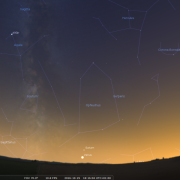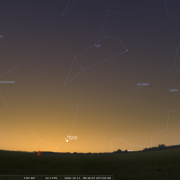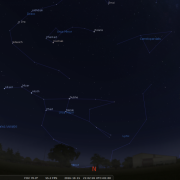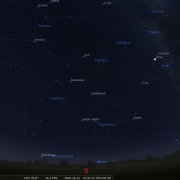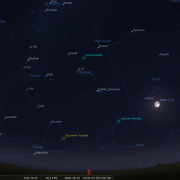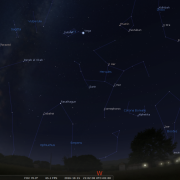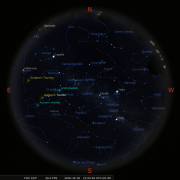Welcome to the WDAS monthly newsletter for October 2016: a digest of the month's latest contributions to our website. Below you'll find Society News, Sky Notes and In-Focus articles printed in full. There's also future events, and trailers for other articles which appear in full on the website - just a click away!
On the website you'll also be able to comment on articles, and if you'd like to play an editorial role in creating new content, just let us know!
Society News
This year’s foray over to Westerdale on Sept 2nd remarkably coincided with crystal clear skies once again, in fact we could not have wished for clearer ones. It was obvious on arrival at the village hall car park that a sizeable gathering was present, induced out by the fine conditions (or was it society stalwart John Randles – the Godfather of Westerdale. Whatever, we received a warm welcome as usual. Whilst John and Mark were talking a barn owl flew out across the drop next to the site, a fine start to proceedings.
Whilst Keith and Mark sorted the telescopes out - just the two this year - Andi Ye, who had managed to make it back early from an appointment in Scarborough, helped with the IT equipment in the village hall. This was utilised by Mark to give a brief presentation using the Starry Night program, whilst skies darkened sufficiently. A rolling power point slide show was left running for anyone to watch, whilst not outside.
It wasn’t long before skies were sufficiently dark for our first objects. First up, Saturn and Mars, visible low in the SW. Saturn received all the plaudits, whilst Mars... Oh damn, it’s gone behind that tree, oh well! From our dark location and under transparent conditions, deep sky objects looked amazing, far better than anything experienced so far this year. The Milky Way arched overhead in striking fashion, before cascading down to the SW horizon, with the northern rift, a huge dark intervening dust cloud, clearly evident through Cygnus.
Given that the Perseids had been predominantly clouded out, it was therefore rather satisfying that sporadic meteor levels that night were very healthy, almost a dozen were spotted, much to the delight of all. Mark and Keith also pointed out numerous artificial satellites using the laser pointers. Before proceedings finally came to an end, Uranus and Neptune were targeted, as well as Pluto, although which one of the numerous faint points of light Pluto was, was anyone’s guess.
An exceptional night all round then, made all the more special by our friendly hosts.
The following evening (3rd) was scheduled to be the Hook’s house camp site star party, however conditions were decidedly incompatible to any form of event, so it was postponed for a week. The 10th our contingency date, turned out to be far more conducive for a star party. Skies were almost as clear as Westerdale, the big difference being the moon, a full half, so natural light pollution was more evident. Five members had made it across, and with 5 scopes set up, there was enough instrument ‘eye candy’ to attract the campers from a pretty full campsite.
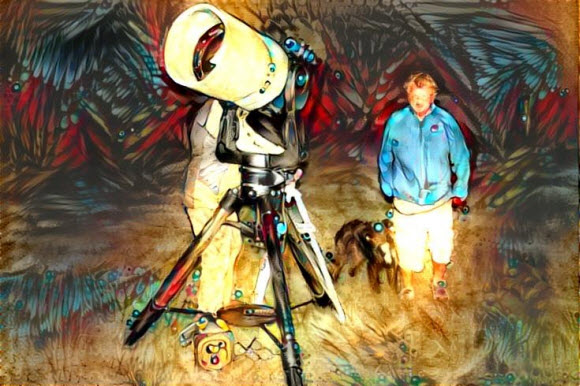
10-Sep-2016 at Hook's House Farm: few photos captured on the night and needed
the deepest possible Google dream to titivate.
Taking advantage of the unobstructed views to the SW, Saturn and Mars were our early targets, with queues soon forming behind the scopes to view them. As darkness fell Mark was able to give a laser point tour of the night sky, whilst Keith, Lee and Warren sought out various summer sky wonders. Andi manned the burger van, well, the boot of his car, doling out homemade hamburgers and hotdogs in buns, whilst Mark’s container of mini sausage rolls were also offered round. These star parties are not good for the waistline.
Views of the moon proved a huge draw, the terminator edge crossing some fine lunar scenery, including Copernicus, Clavius, and the lunar Apennines. Stunning vista’s which impressed everyone. As the evening wore on conditions became a little more chilly and as people drifted away back to their caravans and tents, Winter (which we all should know, is coming) did appear over the hedgerow to the east, otherwise identified as the Pleiades. Just time for one more hotdog before we departed. Thanks to all those members who came along and Hook’s House Farm for their cooperation.
A couple of unscheduled star party events were held on the cliff in an effort to counterbalance those events rained off, or clouded out.
On the 17th we fell foul to inaccurate weather forecasting ( not for the first time this summer) when evening conditions dramatically improved at the last minute - too late though for any preparation to be made, so it was agreed not to bother.
Mark managed an unscheduled sole star party event one Friday, which turned out to be quite successful. It has to be said though that for one reason or another, our summer star party season seems to have been a struggle. Put it down to poor forecasting, bad luck, bad timing or busy home/work schedules, it’s been one of those seasons.
- Mark will be giving a talk at the Museum for the Whitby Literary and Philosophical Society on October 15th at 14:00h: The Autumn night sky.
- A Star Party on October 21st will be held at Mrs M Johnston’s, Ferndene House, Fylingthorpe to raise funds for the ‘Brighter Futures’ charity, helping African children get an education.
It is due to start from 19:00h so we would need to be there by 18:45h. There is a large back garden and a gazebo will be erected for the occasion providing cover. Further details will be given at the Oct monthly meeting.
- Although there are no firm details just yet, there may be a couple more star party events in October, with Fylinghall School likely and one at Egton possibly on the cards. Again if information is forthcoming before our meeting on October 4th it will be divulged then.
Following the toppling of the Whitby museum dictator, and the restoration of sanity (and hopefully all amenities) we shall discuss at the forthcoming October monthly meeting whether it is viable to return.
Apparently hire of the Normanby room will be £20 per hour for local societies, which is very reasonable, however if it is an evening occasion, then the council have to charge a flat rate of £60 to cover costs. This would mean an expenditure of around £200 for a Paul Money lecture.
If we do proceed we would be looking at next spring, April or May of 2017 depending on Paul’s schedule.
Night Scenes 2016
We are now taking orders for Night Scenes 2017 - 25 copies will be ordered. By now you all know how excellent this indispensable almanac is, so don’t delay. Price will be £4.
Sky Notes
In this month's Sky Notes:
Planetary Skylights
 Three planets may be glimpsed low in the evening twilight sky, as long as you have a clear unobstructed SW horizon. Bright Venus skulks just above the horizon all month, half an hour or so after sunset.
Three planets may be glimpsed low in the evening twilight sky, as long as you have a clear unobstructed SW horizon. Bright Venus skulks just above the horizon all month, half an hour or so after sunset.

 Saturn and Mars may be located further round to the SSW. Saturn appears like a white star, Mars masquerades as a brighter orange one. As the month progress Saturn and Venus close up and by the 29th they appear one above the other (Venus will be below Saturn) View around 18:15h. The moon lies closest to Venus on the 3rd, Saturn on the 5/6th and Mars on the 8th.
Saturn and Mars may be located further round to the SSW. Saturn appears like a white star, Mars masquerades as a brighter orange one. As the month progress Saturn and Venus close up and by the 29th they appear one above the other (Venus will be below Saturn) View around 18:15h. The moon lies closest to Venus on the 3rd, Saturn on the 5/6th and Mars on the 8th.

 At the start of the month Jupiter and Mercury reside in the early morning sky. Jupiter is initially lower than Mercury and far brighter. Mercury starts the month around 6 degrees above the east horizon, however it will have dropped out of sight again by 17th.
At the start of the month Jupiter and Mercury reside in the early morning sky. Jupiter is initially lower than Mercury and far brighter. Mercury starts the month around 6 degrees above the east horizon, however it will have dropped out of sight again by 17th.
View from the 8th-13th when the two planets are in close proximity with Mercury dropping from above Jupiter, to below, over this period. The pair are closest on the 11th. You will require an unobstructed east horizon, view around 06:40h. As the month progresses Jupiter begins to climb further into the east sky earlier each morning. The crescent moon lies above it on the 28th.
Meteor Showers

There are a number of meteor showers this month, the weak Piscid shower has three peak dates, Oct 13th being the optimum. Observed rates are little better than sporadic levels - around 3-7 per hour. The Giacobinids or Draconids peak on the 9th. The shower is very erratic, but can produce outbursts of activity so keep an eye open.
The most reliable shower is the Orionids, peaking around the 21st. Like May’s Eta Aquarids, Orionids are associated with Comet Halley, Orionids are swift, often producing persistent trains. Hourly rates are in the mid twenties; however with light from a full moon hampering, observed rates will be substantially lower this year.
October 2016 Sky Charts
Click each image to see a full-size Sky Chart:
|
Looking North
Mid-October - 21:00h |
Looking South |
|
Looking East
Mid-October - 21:00h |
Looking West
Mid-October - 21:00h |
|
|
|
|
Overview
20th-October - 21:00h |
|
Additional Image Credits:
- Planets and Comets where not otherwise mentioned: NASA
- Sky Charts: Stellarium Software
In-Focus
I always view early autumn with a certain amount of nostalgia as it was around this time I first became interested in identifying the stellar patterns visible in the night sky. As it turns out early October is almost ideal to do so;- summer constellations remain well placed as soon as darkness falls, those associated with autumn take centre stage later in the evening and waiting in the wings is the brilliant stellar canopy of winter, a vista to savour. Of course I knew nothing of this as a young boy, but having just acquired a pair of second hand binoculars, a couple of astronomical books, and inspired by the many wonderful tales and legends associated with the constellations, early October seemed particularly suitable.

Google Dream image of the Two Bears: Ursae Major & Minor, overlayed for emphasis.
I took my first celestial steps with one of best-known star patterns, the Plough, the outline of which resembles a ‘dot to dot’ saucepan (also known as the Big Dipper). The Plough is really an asterism, a distinctive pattern within a constellation – in this case Ursa Major, the Great Bear. Throughout autumn evenings the Plough resides at an observer friendly altitude in the NNW as it endlessly circles celestial pole.
In Greek mythology Ursa Major represents Callisto, daughter of King Lycaon of Arcadia who after a liaison with Zeus bore a child, Arcas. In order to save Callisto from his enraged wife Hera, Zeus turned Callisto into a bear. Many years later whilst out hunting, Arcas was about to kill a large bear when Zeus hurriedly intervened; knowing the bear to be Callisto, and turned Arcas into a bear also. Reunited, mother and son were then swung into the heavens out of harm’s way by their tails. Ursa Minor represents Arcas.
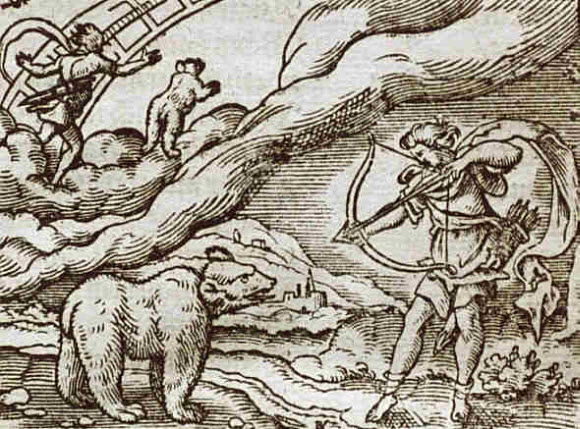
The story of Calisto and Arcas
Five of the stars forming the Plough asterism are genuinely associated, sharing the same speed and trajectory through space. These, along with a number of other stars in the northern part of the sky, as well as Sirius, brightest star in the night sky, are all members of the Ursa Major moving star cluster. If you have decent eyesight you should be able to detect that the middle star in the handle is double. Binoculars show Mizar and Alcor well, but a telescope also reveals that Mizar itself is a striking double star.
There are numerous deep sky objects dotted around Ursa Major, most of which require a scope to spot, but the twin galaxies of M81 and 82 are somewhat brighter, even visible as smudges in binoculars.
Ursa Minor is rather a faint constellation and is home to Polaris - the present pole star. Use the ‘pointer’ stars; to track it down.
Return to the Plough and follow round the curve of the handle to locate Arcturus, the brilliant star low in the WNW highlighting the outline of Bootes the Herdsman. To the upper left of Arcturus look for the delicate starry circlet of Corona Borealis - the Northern Crown. Its leading star, Gemma (latin for jewel) is set in the midst of this pleasing arrangement. According to Greek legend Corona represents the crown of Dionysus, tossed into the heavens to prove his love for Ariadna after she had recently been deserted by Theseus (from the Minataur legend) vowing never to marry a mortal again. Dionysus was a god of course.
The Herdman’s dogs - Canes Venatici - are situated beneath the Ploughs handle and marked by two stars. The brighter one, Cor Caroli, meaning Charles’s heart, was named in honour of King Charles II.
My favourite tale for this part of the sky however stems from the Iroquois Indians and ties in Corona, Arcturus and the stars of the Plough or Big Dipper. Represented by the stars of the Plough the bear is hunted by seven warriors when each spring the animal leaves its den; Corona Borealis. The bear is not killed until autumn whereupon its spirit is released; represented by setting Arcturus, whose name means ‘Bear Keeper’. The skeleton of the bear, the seven stars remains in the sky until the following spring when a new bear emerges from Corona, complete with renewed spirit and the hunt begins again.
Through the eyes of a small child such stories woven by our ancestors on the grandest of scales not only brought the starry heavens to life, but actively encouraged in setting out on a voyage of celestial discovery. Hopefully they still have the capacity to enhance your appreciation of the night sky.
Having shown how the familiar star pattern of the Plough may be used to locate other constellations in the north and west part of the sky, another highly useful arrangement of stars currently visible in the autumn sky may be utilised to pick out aspects of the South and East.
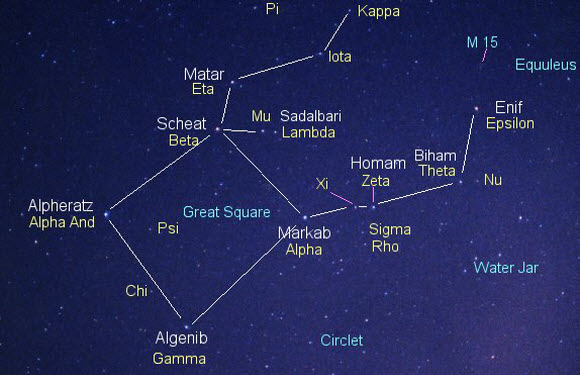
Labeled chart of the Pegasus (Image courtesy Illinois University)
This arrangement, known as the ‘Square of Pegasus’ – part of the constellation of Pegasus itself, is located quite high in the South-East during the evening. The stellar members of this large asterism are not particularly conspicuous, but appear so due to the lack of other stars within this region. Located at the top left hand corner of the square is Alpheratz, which is actually the chief star of Andromeda. Remember we can use this star as the jumping off point to find the Andromeda galaxy. Travelling clockwise around the ‘square’, we encounter the stars; Scheat, Markab and Algenib. By following a line diagonally through Alpheratz and Markab (alpha Pegasi), and continuing on down to the SE you are first guided to a zig-zag arrangement of stars representing the water jar, part of the zodiac constellation of Aquarius, the Water Bearer. Continue on this same trajectory and you will locate Capricornus - the Sea Goat, just above the SSW horizon.
Return back to the ‘square’, and by sighting down through the rear two stars; Scheat and Markab, you will eventually drop upon on a conspicuous star just above the SSE horizon - Fomalhaut. This star marks the mouth of Pisces Austrinus - the Southern Fish, a constellation that barely rises from our latitude. Fomalhaut is thus the most southerly of first magnitude stars (those ranked brightest) visible from Britain. The constellation’s northern counterpart – Pisces, occupies a large portion of the sky below Pegasus. A faint circlet of stars directly below the square represents Aphrodite the western fish; whilst the eastern fish, Heros, lies below Andromeda. A ribbon of faint stars joins the two.
The largest sea creature in the heavens - Cetus, the Whale - may be hunted down by using Alpheratz and Algenib as pointers. They point down toward its brightest star, Deneb Kaitos or Diphda, which marks the great tail of the creature. The head, another irregular loop of faint stars (apart from Alpha Ceti -Menkar) lies below Aries.
The most celebrated object in Cetus is a variable star called Mira “the wonderful”, an extraordinary pulsating red super giant perhaps 300 million km (200m miles) in diameter. At maximum, which Mira is in November, it is visible to the naked eye, but when at minimum seven months later even binoculars struggle to pick it out. Mira lies roughly midway between Menkar and Diphda. See if you can spot it in binoculars.

